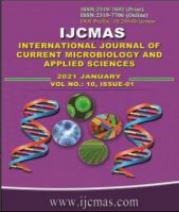


 National Academy of Agricultural Sciences (NAAS)
National Academy of Agricultural Sciences (NAAS)

|
PRINT ISSN : 2319-7692
Online ISSN : 2319-7706 Issues : 12 per year Publisher : Excellent Publishers Email : editorijcmas@gmail.com / submit@ijcmas.com Editor-in-chief: Dr.M.Prakash Index Copernicus ICV 2018: 95.39 NAAS RATING 2020: 5.38 |
Women in India are major producers of food in terms of value, volume and number of hours worked. It is observed that women play a significant and crucial role in agricultural development and allied activities. Further the Self-help group’s genesis had further kindled the women empowerment in agriculture. In Dharmapuri district of Tamil Nadu, India, the SHGs have a considerable presence and especially contributing to development of women. These SHGs have enhanced the income, employment and asset position of rural women and had increased their decision making activities. Hence to study these impacts, the study was proposed. Percentage analysis, Cobb-Douglas production function and Log it model were the analytical tools used to evaluate the objectives. The results revealed that in both the SHG groups, more proportion of SHG members was in Rs. 5000-Rs. 10000 income groups. A comparative higher saving was observed in NGO SHG and a comparative low saving was observed in Government SHG. After joining SHG, the economic empowerment occurred in both the SHGs. Higher employment days in categories of 100-150 days, 150-200 days and above 200 days was observed in NGO SHG even though the mean employment was similar in both the groups. The asset ownership was higher in NGO SHGs as compared to Government SHGS. In both the SHGs, women respondents consulted other family members in economic activities of purchase and sales decision and in household activity, they themselves taken the decision. NGO SHG performed better with respect to productive efficiency, income generation rate and repayment rate than Government SHG. First three major constraints faced by Government SHG women were lack of knowledge of account procedures followed by Improper training facilities and less marketing Opportunities for product. Whereas in NGO SHGs, the major constraints found was are more borrowings followed by inadequate fund and lack of knowledge of account procedures.
 |
 |
 |
 |
 |